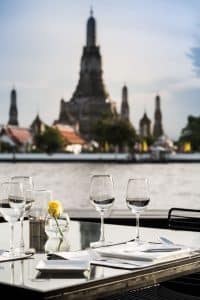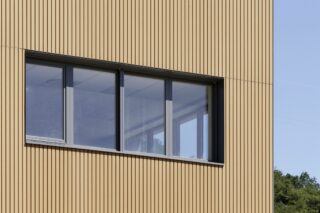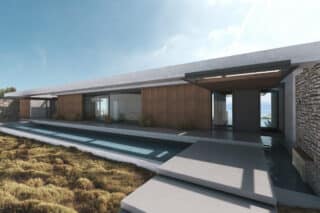Along the Chao Phraya River, the Sala Rattanakosin hotel offers a mesmerizing view of Bangkok. The reception area leads to a window gaze of the Temple of Dawn, reminding visitors of the cultural beauty that no modernity wishes to exclude.
Thai architecture and interior design firm Onion accomplished the transformation of seven shop houses into the Sala Rattanakosin hotel in 2013, with the intention of guiding the visitor’s eye outward, beyond the space. Moving from the inside out, the surrounding context becomes the focal point.
A First Encounter
When Onion first encountered the space, they were impressed by the dynamic atmosphere of the area. The bustling sounds of Ta Tien community and the captivating views surrounding the structure, such as the Chao Phraya River, the Pho Temple (or the Temple of the Reclining Buddha), and the market life along Maharat Road became an essence of the undertaking.

Sala Rattanakosin by Onion
They transformed the 1,500 square meters into 17 rooms, restaurants, an outdoor deck, an indoor and rooftop bar, with several outlook spots. Each room has an uncluttered window view, while the open-air rooftop bar reveals the glittered city.
 Mimicking the exterior sights in the interior, Onion created a graphic using the temple’s silhouette. This is repeated on a dual-reflective and transparent, laminated space-divider in the upper restaurant. The partition is black and gold with a mirror-like effect that recalls looking through a window. While the picturesque moments remain sophisticated and elegant, Onion was careful not to exaggerate Thailand’s sacred and traditional designs.
Mimicking the exterior sights in the interior, Onion created a graphic using the temple’s silhouette. This is repeated on a dual-reflective and transparent, laminated space-divider in the upper restaurant. The partition is black and gold with a mirror-like effect that recalls looking through a window. While the picturesque moments remain sophisticated and elegant, Onion was careful not to exaggerate Thailand’s sacred and traditional designs.
“To name the traditional Thai aspects is perhaps to identify what the Thai people would not do. They would not point their feet to Buddhist Temples. In the bedrooms, we placed the beds parallel to the Chao Phraya River, not perpendicular,” Arisara Chaktranon from Onion, told ArchiExpo e-Magazine.
Playing with Geometry & Materials
Preserving the continuity between the space and its surroundings, the history of the structure was exposed or imitated. The elements within the space mix modern attitude with the structure’s commercial past. In the entrance, for example, one enters through an aged door, reminiscent of another time, to a space that is full of modern shapes created with antique materials or antique-looking elements created recently.

Sala Rattanakosin
“Certain existing elements of the shophouses such as ceramic tiles and wooden doors were fascinating so we used them to develop our own design— an interplay between the aged and the newly customized materials,” Arisara Chaktranon from Onion, told ArchiExpo e-Magazine.
Peeling back layers, the designers were inspired to create their own pieces to add to the new identity of the space. For example, the geometric black and white tiles found adorning the hallways are not salvaged from the space. Those were designed by Onion and crafted locally. Although traditional Thai motifs or fixtures were avoided, attention to local production was favored.

Sala Rattanakosin
“Our materials and objects were mostly produced and custom-made in Thailand. We worked with local craftsmen such as those who made the washing basins, the lighting fixtures and the ceramic tiles.”












